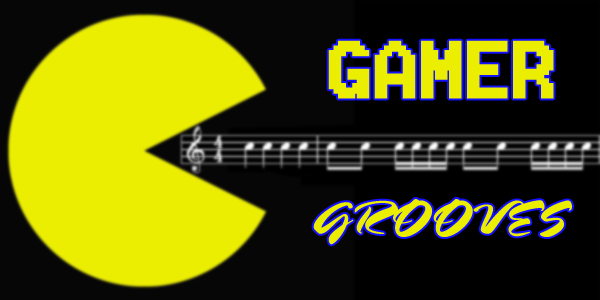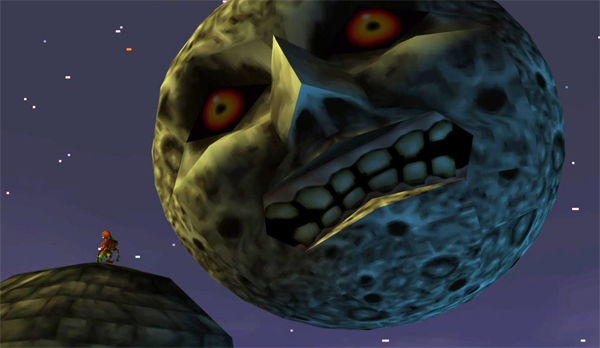
As always, a friendly reminder that this post may contain spoilers.
What was once a dark horse in the Zelda series soon became one of the most well liked games on the internet. Majora’s Mask tackled themes and character arcs that were very dark and real. The characters and the situations are obviously fantastical, but what strikes a chord with so many people is how believable each person in the game is. Majora’s Mask takes place in the parallel world of Termina (that is, parallel to Hyrule) where Skull Kid has been corrupted by the titular mask. With the power of the mask, Skull Kid wants to bring down a moon on Termina, so that in three days time, all would be obliterated. The moon hangs in the sky and gets closer every day. It didn’t help my fragile psyche that the moon looked like this:

Look, I’m not going to act like having this angry moon bring the world to ruin wasn’t a bit stressful. Even though I could go back to Day 1, I never felt like I had enough time to do what I wanted. In fact, the time limit is what turned some gamers off of Majora’s Mask despite the praise it gets from others. But enough talk about the mechanics: Who did the soundtrack?
In a totally unintended turn of events, the main composer of Majora’s Mask is once again Koji Kondo, except for three battle themes that were done by Toru Minegishi. Where Mario games tend to be more upbeat because of the platforming-action, Zelda is generally about the adventure, so the songs change accordingly. Majora’s Mask has the darkest tone of any Zelda game, so having a particularly moody backdrop to most of the songs is to be expected. Although, this doesn’t stop each piece of music from having its own distinct feeling.
Songs
Song of Healing
The Song of Healing captures the feeling of about 90% of Majora’s Mask. Many of the people in the world of Termina are aware of the catastrophe that is going to befall them. As the days progress and the end draws near, inhabitants begin to do what they can and prepare for the end. Staying with loved ones, cowering in a corner, and many more reactions can be seen from those that live in Termina.
The Song of Healing has two different meanings, in my opinion, both of which deal with acceptance. For those that are deceased (in game), it’s a song about moving on, putting aside their responsibilities to those that are still living. Characters like Mikau and Darmani don’t wish to leave, and they fear that what they did in life might all be in vain, so Link plays the song that lets them rest easy knowing their loved ones will be taken care of.
In Termina, the Song of Healing doesn’t so much offer hope for those of the living, instead it offers comfort to those who need it while never denying the inevitability of the impending apocalypse. The somber melody sooth the heart, but not quite the very real threat to the world they live in. It’s still important though; everyone deserves a little personal happiness outside of things they can’t control. It’s pretty much the cornerstone of the Majora’s Mask soundtrack to me: being able to capture the theme of the game so well.
Clock Town Days 1-3
For easy reference: Day 1 is 0:00 – 1:26, Day 2 is 1:30 – 2:35, Day 3 is 2:37 – 3:44, and The Final Hours are 3:47 – 5:50.
Day 1 is a fun song that represents the stuff to do in Clock Town along with the preparation for the Carnival of Time. You can see the moon in the sky, but from the way the music plays, 3 days seems so far away, and there’s plenty of time to enjoy yourself. After all, time flies when you’re having fun!
Day 2 understands that there’s much left to be done. The pace quickens ever so slightly and loses some of the frills of Day 1. There really aren’t any tremendous differences between Day 1 and 2. It keeps the upbeat tone, but with less “stuff” to listen to, you can begin to notice that the moon is definitely getting closer…
Day 3 starts to get uncomfortable. The moon is very close now, and a dark underscore is seeping into the song. It feels like you’re trying to ignore it, but doom is right around the corner. Once it hits midnight on the 3rd day, The Final Hours begin. The frequent earthquakes from the moon entering the atmosphere (which were getting more frequent by the day) represent that feeling of “the end is near” just as well as the music. It reflects the final deadline: Either you stop this moon now, or run back to Day 1 because you won’t be able to handle it.
Stone Tower Temple
I really like Ikana Canyon. Not because of the creepy vibe, of course, but because of how the area is dripping with history. The game does a great job of making you feel like you’ve stepped into the world of an ancient kingdom long since past. It doesn’t feel like it’s filled with the undead for the sake of it, but instead that these are remnants of the Ikana who have decided that the war is not over.
The music for Stone Tower Temple is great because it feels like it’s exploring that rich history. It’s almost as if Link has stepped back in time to experience the culture, while at the same time the theme is clearly thinking of the kingdom in the past-tense. It’s fitting because the temple itself feels like it’s stuck between past and present, and with no part in reality to call its own. Stone Tower Temple is a really unique dungeon; I can’t think of any dungeon other than Ancient Cistern in Skyward Sword that really wowed me as much in the Zelda line. Koji Kondo made Stone Tower feel as unique as the world around it.
Calling the Four Giants
http://www.youtube.com/watch?v=-yV5uEmoRIo
After completing the four dungeons and releasing the giants that were trapped in each, it’s finally time to stop Skull Kid. Standing atop the Clock Tower at the end of Day 3, you find yourself in the same situation you were in at the beginning of the game. Skull Kid calls down the moon even faster, and usually this would be the moment that you play the Song of Time and get back to Day 1. But not this time…
You play the song that you were taught by the giants, and do it at the time they need to be called. The Oath to Order sounds, and this song plays. The moon is crashing down, but the lanky ancients come from the four corners of Termina and work together to hold the moon at bay. Their knees buckle, their arms shake, but with the desire to protect the world, they hang on and stop it before impact. Calling the Four Giants represents the sense of hope that Termina has deserved after all the hardship. The giants, and Link by proxy, have stopped the horrific plan by Skull Kid and Termina is saved! …That is until the Majora’s Mask comes free from Skull Kid’s face and reveals that it has been pulling the strings all along. It heads into the moon itself and the lunar body shifts into overdrive. The giants begin their struggle again, and Link chases Majora’s Mask inside to finish Majora for good.
Majora’s Wrath
http://www.youtube.com/watch?v=VomJdggSS88
After a battle with Majora’s Mask and the goofy Majora’s Incarnation, Majora reveals he is done playing around. The body of Incarnation pumps up its muscles, grows an Oni-like face, and extends two whips out of his arms. The final and toughest phase of the fight, (unless you have the Fierce Deity’s mask) Majora’s Wrath doesn’t pull any punches. I like to think that this theme cares so much impact because you have spent the entire game watching the world suffer, and finally have the chance to end Majora by your own hands.
Saying that his theme shows off his pure evil would be stating the obvious. It (like Majora) is not trying to hide that evil, but really just accentuates in it. In this battle, you carry not just your determination and courage, but the hope of all of Termina. So the song helps you feel that when it’s all over, the satisfaction will be through the roof.
Afterthoughts
If I had to rank Majora’s Mask amongst my top three Zeldas, it would battle for 1st with a game that I won’t name right now (Tease!- EDITOR FRANK). The game is great, not just for the dark tone, but for how the time limit makes you think about what has to be done and how you should do it. If you initially had any doubts because of the time limit, I strongly urge you to pick up the game and try it again. I promise that with patience, Majora’s Mask will find its way up to the top of your Zelda favorites as well.
Thanks again for reading today! Comment on the post below with what songs you liked that I might have missed, or what you thought about the post itself. Either way, I’ll see you all tomorrow!
“Dawn of the First Day: 72 Hours Remain”
